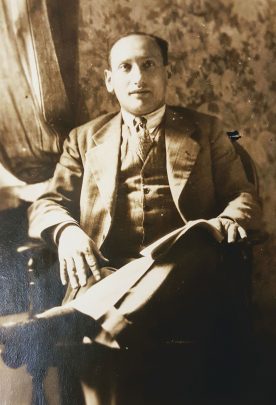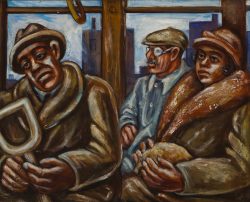Morris Topchevsky, from an undated photograph, Morris Topchevsky Papers, box 1, folder 3, University of Illinois at Chicago, Richard J. Daley Library, Special Collections and University Archives.

Morris Topchevsky 1899–1947
Morris Topchevky’s father was an iron worker and labor activist in Białystok, Russia (now Poland). To escape the pogroms in which four of Morris’s siblings perished, the family emigrated to the U.S. when he was ten and settled in Chicago. After high school Topchevsky worked in a sign painting business and studied art with Enella Benedict at Hull-House, the settlement community founded in Chicago’s West Side immigrant neighborhood by Jane Addams and Ellen Gates Starr. He then enrolled in the Art Institute of Chicago, where Albert Krehbiel was among his most important teachers. Topchevsky’s early paintings, many of them scenes of Chicago, met with some success in exhibitions in Chicago, in Philadelphia at the Pennsylvania Academy of the Fine Arts, and elsewhere.
In 1924, Topchevsky traveled to Mexico, then attracting numerous progressive American artists eager to absorb the example of a social justice-driven art advanced by Diego Rivera and others. In addition to meeting with Rivera and his circle, Topchevsky traveled and worked as a draftsman on an archaeological excavation and studied at the Academy of San Carlos in Mexico City. After two years in Mexico Topchevsky returned to Chicago to teach at Hull-House, where his pupils included his younger brother Alexander (Alex Topp). He spent three more years in Mexico as a lecturer, followed by an appointment to the faculty of the short-lived University of Wisconsin Experimental College.
In 1932 Topchevsky became a resident instructor in the Abraham Lincoln Center in Bronzeville, the African American neighborhood on Chicago’s South Side; among the many students he mentored were painter and printmaker Charles White and author Richard Wright. “Toppy”’s commitment to art as an expression of and means toward the liberation of the oppressed deepened further in response to the widespread privations of the Great Depression and the rise of fascism in Europe. By 1936 he was described as the “leading leftist among Chicago artists” and “frankly a propagandist” in his art.i Employed in the WPA’s Illinois Art Project, he helped organize artists in the Chicago Artists’ Union. He was also active in the John Reed Club, the leftist American Artists’ Congress, and the American Jewish Art (later Arts) Club, formed in 1940 from the organization Around the Palette as a response to Nazi oppression of European Jews. From the early 1930s until his premature death at the age of forty-eight, Topchevsky created prints and oil and watercolor paintings that forthrightly protest discrimination, oppression, poverty, and intolerance, conveying his conviction of the power of art to improve society.
Wendy Greenhouse, PhD
i C. J. Bulliet, “Artists of Chicago Past and Present. No. 70: Morris Topchevsky,” Chicago Daily News, June 27, 1936.
